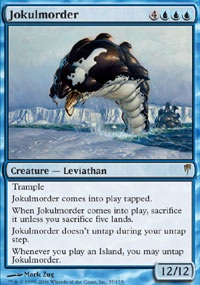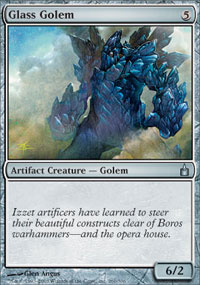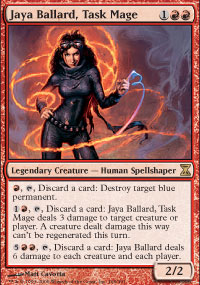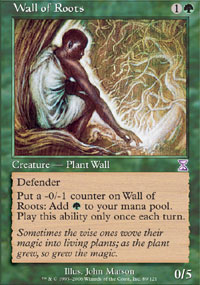I am not, nor will I claim to be, a good player.
I'm not a terrible player either, but I am a long, long way from being able to show up at a PTQ and reasonably expect to come out in the top eight. Usually I'm happy to make the top 20.
I have played a lot of games, however. Lots and lots of Limited. And after about 100 or so drafts, my MTGO record is 1630.
I mention all of this not to warn you that what I'm about to impart is total bunk, but only to remind you that you should take everything you read here with a grain of salt.
I've always thought that the best way to learn is to read the comments section after the article. That's where the real insight tends to be because it offers a series of differing opinions, as opposed to the one-sided, 'I-know-all-there-is-to-know-about-this' tone that most articles on general strategy tend to become.
This is a compilation of my first impressions on Time Spiral in limited formats. The most interesting thing about Time Spiral from the limited perspective is rarity. The Purple cards come one per pack and replace a common. These are occasionally second rares. It's also possible to get three rares in a pack if you happen to be really lucky (or really unlucky if it's a draft... who wants to pass two rares?) because foils are replacing commons now, instead of cards of similar rarity. What this all amounts to is a lot more powerful, once-in-a-while cards floating around the table. This has a tendency to make the game a lot more bomb-oriented. Just assume that everyone has something super-awesome to bring out in the third act.
“What about [Your Card Here]?”

Everyone knows Jokulmorder
is a credit-card scam.
If I didn’t mention your awesome card that won you all kinds of games it’s probably because it’s not something that a player can expect to have in front of him every other game. Besides, do I really need to tell you to grab that Akroma? Most of the ridiculously awesome rares speak for themselves, and most of the good solid common creatures are straightforward enough that their merits are staring at you right there in the lower right corner of the card. I do have one word of warning, though. Ignore the text box. Well, don’t ignore it, if a 10/10 says “Lose the game when this comes into play unless you give target opponent all your credit-cards,” you might want to pass on that, (I’m looking at you, Jokulmorder) but it’s very easy to get so caught up in considering whether a creature’s text-box has any merit, that you completely forget that it’s a 3/4. In most cases in limited, that’s enough.
Slivers are Combo-licious
Although it is possible to draft a really powerful sliver deck, it’s important to remember that slivers have always been a double-edged sword. If you can get a hold of a Hivestone, it’s well worth the trouble to pick out the sliver army to back it, but you must always be mindful of the fact your slivers pump your opponent's slivers, too. This effectively means that you each have X copies of the same creature, where X is the number of slivers you control. In sealed deck, it's less of an issue, because it's unlikely that anyone is going to have a focused, sliver deck. These are some powerful creatures in their own right; they’ll probably win you some games. The main rule to remember about slivers is this: If you play them, you’d better be sure that you will have the most slivers on the board. Most of the time, this won't matter as your slivers get boosted by your opponent's too, but if you don't have a backup plan, it could come back to haunt you.
My Favorite sliver deck archetype is Blue/Red. Red has the power-pumping Fury Sliver and Bonesplitter Sliver. Not to mention the powerfully offensive Two-headed Sliver. Blue contributes Shadow Sliver and Telekinetic Sliver but the main thing it adds to the deck is Snapback. The ability to suddenly remove a key sliver from the battlefield gives you that extra combat edge in case you should be faced with another sliver deck. Red has plenty of instant-speed sliver removal, too, but most of it is a tad too permanent for me to be comfortable pointing it at my own creatures
White
Removal
Temporal Isolation is the only other common that can be used as decent, size-independent, removal, the only real drawback is that it gives your opponent a shadow blocker. It's more akin to Heart of Light than Faith’s Fetters or Pacify, but removal is removal, and this does the trick.
Gaze of Justice is the only pure removal spell on the board and can be good, but usually it's only useful when you're already winning. It won’t be saving you from any serious jams because you’ll need three white creatures to use it.
So you’ll probably find yourself relying on combat tricks to Restore Balance to your side of the board. Fortunately, that is one area where White shines. Momentary Blink is quite possibly the best common combat trick I’ve had the displeasure of being at the wrong end of. You can’t truly appreciate this card until you’ve seen it in action, but let me tell you, it’s a thing of beauty. “Damage on the stack, Momentary Blink not only is my Cloudchaser Kestrel/Ivory Giant/Jedit’s Dragoons unharmed, but it comes into play again. A Ha ha ha ha! Ha.”
D’Avenant Healer is just plain awesome. Get two of these guys on the field, and there’s not much your opponent can do to regain the advantage. Get four of these guys in a deck, and you can dictate who dies when. Or who lives.
Zealot Il-Vec is just plain good. He sneaks, he shaves, he pings. What more could you ask for? (Please don’t answer that.)
White deck archetypes
If you’re playing White, you’re probably here for the air force. White is good at gumming up the ground while damage sails by overhead. Don’t run from this, embrace it. Anything with flying is worth grabbing in this color. If you go for White’s forte, evasion control, you won’t be disappointed.
Another tack is the rebel synergy. A general deck will probably end up including a few of these guys anyway. One of them, Amrou Seekers, has White Fear, and the aforementioned Zealot Il-Vec is awesome and shadowy, so there is a lot to work with if you go for the rebel deck. This, like the sliver deck, is an archetype that only works well in draft, and only if you’re the only person at the table going for it. Ideally, you would want to build the rebel deck when there are only one or two other people in White, and they are going for the flyers, but I’ve never seen anyone win very much by drafting pure rebels, but you should definitely include a few on their own merits. Amarou Scouts tutor for scouts, which amounts to card advantage, and card advantage wins games.
White synergizes well with Green, by patching up the gap in the air that green tends to have, and especially well with Blue. Blue/White control decks are my favorite kind to draft, and this set gives you more than enough material to build one.
Blue
Blue is quite possibly the most powerful color in the set in terms of pure chicanery. To prepare to write this article, I made a list of all the prominent commons that absolutely had to be mentioned. Blue had about four times more than any other color.
The primary goal in limited is to have more cards on the board than your opponent.
This is the main thing to remember about Blue: you can’t draft an answer to everything. There are enough counters and counter-like spells to draft a blue denial deck, but if you don’t have one or two big powerful rares to throw down late game, you’re going to run out of gas.
Notable commons:
Spiketail Drakeling. Wow. I mean wow. A 2/2 flyer for 3 is a great addition to any deck, and the threat of the counter is going to force your opponents to either pitch some removal at it, or delay their big drops a turn or two. I don’t go in much for drafting straight counters. One or two in my final deck tops, otherwise, you lose too much in the form of cards that could have been on the board and doing something instead of sitting in your hand and waiting for your opponent to cast this biggest threat. Spiketail Drakeling sits on the board, doing damage, being threatening, generally being awesome, and the only thing it costs you is the element of surprise. One might argue that the element of surprise is the whole point of counter spells. No one would play their best spell if they knew it was going to hit the graveyard right away, right? Exactly. The whole point of Spiketail Hatchling is that it keeps those cards off the board and in your opponents hand where they aren’t anywhere near as bothersome.
Looter Il-kor I've been trying to avoid mention of the card advantage generators in the interest of brevity. If I went on and on about all the great ways to draw, this would become an article about Blue in Time Spiral, rather than the set as a whole. This guy, however, goes the extra mile by doing sneaky damage while helping you cycle your deck. Include him. You won't be disappointed.
Eternity Snare. It’s expensive, but it eliminates a threat and replaces itself. That’s good enough for a first or second pick in my book.
Snapback. This card is almost better than Peel From Reality. At least as good a combat trick as Momentary Blink. Can be used as a creature save or to clear the way for your attackers, and it might not even cost you mana.

Errant Ephemeron. I made the mistake of misjudging this card once, and I won’t do it again. Forget about the high casting cost; forget about the repercussions of announcing this guy is coming four turns in advance. You’ve got to see past all of that and accept that this is a 4/4 flyer for 2. Period. Okay, so he doesn’t hit the board until turn 6 at the earliest. These guys are cheap, they’re plentiful, and it’s easy to have so many of them suspended and waiting to come into play that there’s no way your opponent is going to be able to deal with them all. I’d fill a deck with these guys if I got the chance.
Fledgeling Mawcor. Okay, so this is an uncommon, but it gives me a chance to point out one of blue's biggest strengths in Time Spiral. That little phrase that we haven't seen on a type two legal blue card in a long long time: "deals one damage to target creature or player." I heart Ping. You should also snag any Tims or Pirate Ships you happen to come across.
Black

Glass Golem; the quintessential
glass cannon.
Black is, as usual, a really really awesome… incredibly powerful… not to be ignored… support color. If you find yourself as the only person drafting a mono black deck, stop. It’s easy to be seduced by all the high power creatures, and the removal, and the evasion in the form of shadow, but that sort of deck belongs in constructed. In limited, you almost never manage to be quick enough to push your Glass Cannons through for 20 damage before your opponent’s deck gets up and running.
Keeping in mind that black is a support color and that you’ll have some powerful white flyers/green beaters to back it up. You’ll want to grab all the removal you can, which is a lot. Cards like Assassinate, Dark Withering Tendrils of Corruption provide you with non-toughness specific creature removal at common-level abundance. Uncommons like Nightshade Assassin and Faceless Devourer remove threats from the board and then act as new threats themselves.
Black also has lots of discard spells and although they do provide you a modicum of control, in the very late game, when your opponent is likely to have little to no cards in her hand, these cards are pretty much just dead draws. My feeling on Discard in limited is similar to my feeling about Life Gain. It’s not good on its own. Divine Congregation is mostly just a wasted card; you shouldn’t include it unless you have some special circumstances, (either a need to extend the game, or intend to spend life that will need replenishing) leave it out. Life gain is much better when it’s attached to something functional like Faith’s Fetters. Discard is the same way. It’s good when it’s attached to Hypnotic Specter or Strands of Undeath, but on Mindstab you’re probably just wasting valuable card space. Only run discard if you intend to use it on both of you for the madness abilities. Psychotic Episode is the best form of hand-hate in Time Spiral limited because you know that you’ll always have at least one card to look at. I’m just not confident enough in it to recommend including it in your limited deck.
The black/blue control deck archetype can be quite devastating in limited, and there is certainly enough of a base to support it. Such a deck would be a very focused collection of evasion and control in the form of creatures with flying, creatures with shadow, creatures with fear, bounce, discard, removal, and counters. I haven’t yet seen anyone actually pull this off, but the card pool suggests it could be quite devastating.
Red

I haven't felt burning this profound since my
ex-girlfriend. Actually, she kinda looks like
my ex-girlfriend.
Of all the cards I listed among the must-have commons in this color, none were creatures. That pretty much sums up red. This color contains a lotta buncha ‘X damage to target enemy and/or her pets.’ Which is great, except that just about every red card you play will be seeing the graveyard very very soon. It’s hard to build up an army with red. The critters are too weak, and in limited, critters are what it’s all about.
This is even more of a support color than black. In almost all draft or sealed games you play, you’ll find yourself looking at including a few red cards, but not a lot of them. Cards like Grapeshot, Rift Bolt and Lightning Axe are just begging to be splashed.
Orcish Cannonade and (if you should be so lucky) Sulfurous Blast should make you think seriously about increasing the involvement of red in your deck. You could flesh out the color with some slivers. Just remember that slivers are only good if you have more of them than your opponent, and more than 5 or 6 removal cards is about the point where your deck starts to get saturated and overall quality starts to decrease.
Green
Green is probably the most straightforward color. Just about every Green deck has the same strategy: Speed up the mana base, drop some big fat, fatties, charge through the defensive line like Chris Farley through a Red Rover line of fourth graders.
It makes sense that most of my must-have Green cards are mana fixers. In limited, you don’t want to be missing land drops or waiting on that third color. Search for Tomorrow is the best mana fixing card since Sakura Tribe-Elder. It can grab a land even if you only have one forest to your name. Gemhide Sliver is a great mana accelerator as well, so long as you don’t mind the fact that you’ll probably be extending your opponent the same courtesy.
Havenwood Wurm is Green's first-pickiest common. 5/6 tramplers rock the board late-game, but this guy doubles as removal because he can pop-up unexpectedly like a gigantic hungry in-law. His only drawback is his cost, but green is full enough of acceleration to take some of the edge off of that. A good deck has 3-5 cards in the 6cc + range. If four of those are this guy, You don't need much else.

I hope I don't have to tell you to grab
one of these if you get the chance.
Strength in Numbers is a great combat trick that can be used either as defense or as a finisher.
Wormwood Dryad is a decent 3/1 that could easily trade for something much more expensive, and it has the potential to sneak damage through against almost all decks. Even though his ability is color-specific, I’d recommend main-decking this guy.
The Thallid deck
Buncha lamers, those thallids. All they do is sit around and bud. Okay, so you get a saproling every now and then and that makes a few of them worth playing, but how much power can a bunch of lazy fungi actually be?
That was my first impression, before I was taken, against my will, to Thallid School. When you get a whole bunch of thallids on the table, they get tricky. Germinator Thallid’s ability makes combat extra dicey with as few as two saprolings in play. Add in some black for Deathspore Thallid ‘s and it’s downright miserable to even bother playing against.
Artifacts and lands
Mana fixing is king in limited. There's nothing worse than losing due to the turn of the color screw. Here's a few colorless solutions to help smooth out your deck building. Pick these guys early, just as soon as the overpowered stuff starts to thin out.
Terramorphic Expanse is a great card. It color-fixes no matter what colors you’re playing, and it trims an otherwise useless late-game draw out of your deck.
Prismatic Lens Grab this over Akroma. Okay, now that I’ve got your attention, grab it over some other, less awesome card, but still, grab it. This is about as good as mana fixing artifacts get.
Chromatic Star It color-fixes and replaces itself. Every deck should have one.
Conclusion
This article will be of little use to my cats. While they can speak, their English comprehension skills leave something to be desired. Hopefully, those humans who have chosen to read this will gleam some useful information to keep in mind when sitting down to their next draft or sealed deck event.
Comments